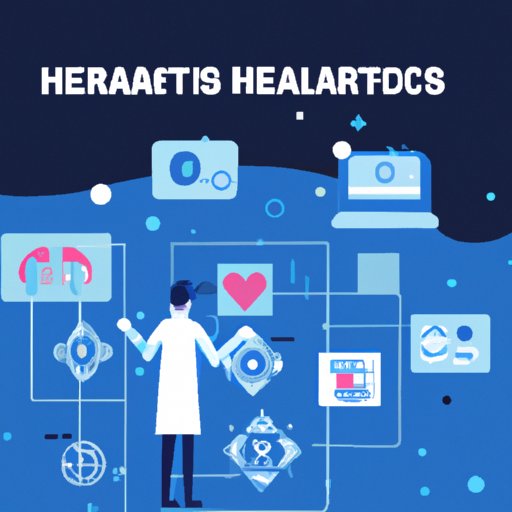Introduction
Health informatics is a rapidly growing field that combines information technology, data science, and healthcare to improve patient care and enhance clinical processes. It involves the acquisition, storage, retrieval, and use of healthcare information for the purpose of decision-making and improving healthcare outcomes.
Definition of Health Informatics
The American Medical Informatics Association (AMIA) defines health informatics as “the interdisciplinary study of the design, development, adoption and application of IT-based innovations in healthcare services delivery, management and planning.”

History and Applications of Health Informatics
Health informatics has been around since the 1960s, when computers were first used to store and analyze medical records. Over the years, advances in technology have enabled health informatics to become an integral part of modern healthcare. Today, health informatics is used in a variety of ways, from electronic medical records (EMRs) to telemedicine and remote patient monitoring.
Exploring the Benefits and Challenges of Health Informatics
Advantages of Health Informatics
Health informatics offers many potential benefits, including improved accuracy and reliability of patient data, enhanced communication between healthcare providers, and streamlined clinical processes. According to a study published in the Journal of the American Medical Informatics Association, “The use of health informatics can lead to more efficient processes, better data quality and availability, and improved patient safety.”
Disadvantages of Health Informatics
While health informatics can be beneficial, there are also some potential drawbacks. These include increased risk of data breaches, privacy concerns, and the need for specialized personnel to manage systems. Additionally, the cost of implementing health informatics systems can be prohibitive for some healthcare providers.
The Role of Health Informatics in Patient Care
Improving Quality of Care
Health informatics can play a key role in improving the quality of care for patients. By providing clinicians with access to real-time patient data, health informatics systems can help them make more informed decisions about diagnosis and treatment. Additionally, the use of EMRs can reduce medication errors, minimize transcription mistakes, and improve patient safety.
Enhancing Access to Care
Health informatics can also help to enhance access to care by enabling remote patient monitoring and virtual visits. This can be especially beneficial for patients in rural areas or those who have difficulty accessing healthcare services. Additionally, telemedicine can reduce wait times and improve the overall efficiency of healthcare operations.
Streamlining Clinical Processes
Finally, health informatics can help streamline clinical processes and reduce administrative burdens. For example, EMRs can automate appointment scheduling, reduce paperwork, and enable healthcare providers to spend more time with patients. Additionally, health informatics systems can help to improve data collection and analysis, allowing healthcare organizations to make more informed decisions about patient care.
The Impact of Health Informatics on Healthcare Costs
Reducing Costs Through Automation
Health informatics can also help to reduce healthcare costs by automating certain processes, such as appointment scheduling and billing. Additionally, the use of EMRs can reduce the amount of paper used in healthcare operations, which can result in significant cost savings.
Lowering Administrative Costs
Health informatics can also help to lower administrative costs. For example, automated systems can reduce the amount of time spent on tasks such as record-keeping and filing, allowing healthcare professionals to focus more on patient care. Additionally, health informatics systems can enable healthcare organizations to more effectively manage their resources, resulting in cost savings.

Emerging Technologies in Health Informatics
Artificial Intelligence
Artificial intelligence (AI) is one of the most promising emerging technologies in health informatics. AI-powered systems can be used to quickly analyze large amounts of patient data, identify patterns, and provide insights that can help clinicians make more informed decisions. Additionally, AI-driven chatbots can be used to answer patient inquiries and provide personalized advice.
Blockchain Technology
Blockchain technology is another emerging technology in health informatics. This distributed ledger technology can be used to securely store and share patient data, ensuring that only authorized users have access to sensitive information. Additionally, blockchain-enabled smart contracts can automate various clinical processes, such as insurance claims and payments.
Wearable Devices
Wearable devices are also becoming increasingly popular in health informatics. These devices can track a range of vital signs, such as heart rate and body temperature, and can be used to monitor patients remotely. Wearable devices can also be used to collect data for research purposes, helping to advance our understanding of human health.

The Future of Health Informatics
Increasing Use of Electronic Health Records
The use of EHRs is expected to continue to grow in the coming years, as this technology becomes increasingly integrated into healthcare systems. This will allow healthcare providers to more easily manage patient data, streamline clinical processes, and improve the overall quality of care.
Improved Data Analysis and Decision Making
Data analytics and machine learning will also become increasingly important in health informatics. These technologies can be used to quickly analyze large amounts of patient data and generate insights that can help clinicians make more informed decisions. Additionally, predictive analytics can be used to anticipate patient needs and provide tailored interventions.
New Opportunities for Remote Care
Finally, health informatics will open up new opportunities for remote patient care. Telemedicine and other forms of virtual care will become increasingly commonplace, allowing healthcare providers to reach more patients and provide timely and effective care. Additionally, remote monitoring technologies will enable healthcare providers to monitor patients in real-time and intervene quickly if necessary.
Conclusion
In conclusion, health informatics is a rapidly evolving field that can offer numerous benefits, from improved quality of care to reduced healthcare costs. It can also enable healthcare providers to take advantage of emerging technologies such as AI, blockchain, and wearable devices. As health informatics continues to evolve, it will bring about new opportunities for remote care and improved data analysis and decision-making.
(Note: Is this article not meeting your expectations? Do you have knowledge or insights to share? Unlock new opportunities and expand your reach by joining our authors team. Click Registration to join us and share your expertise with our readers.)
